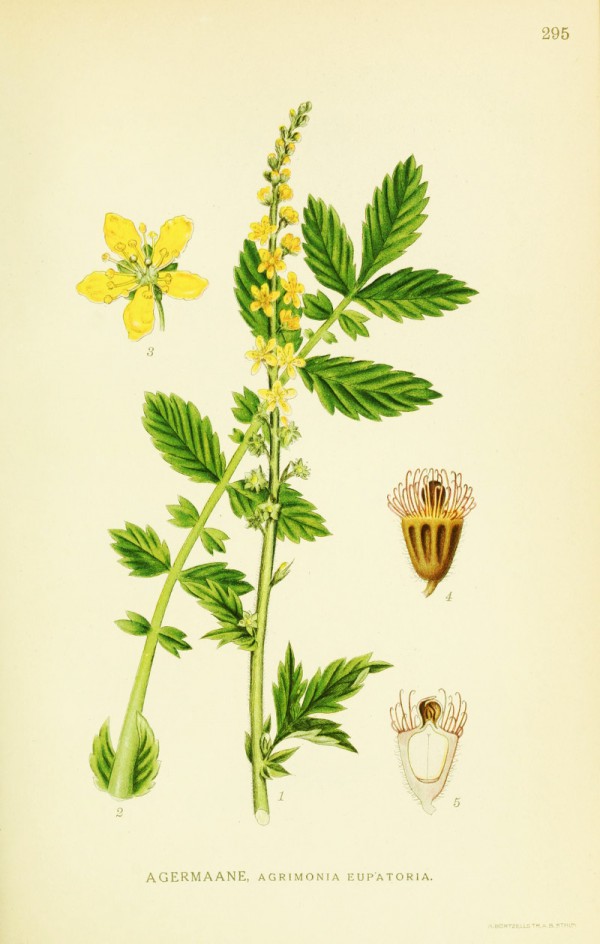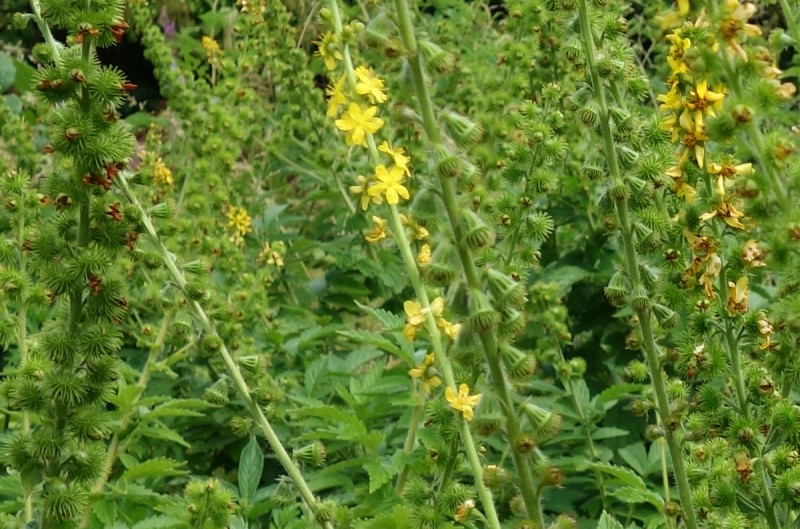Agrimonia eupatoria L. - syn.Agrimonia officinalis Lam. - Rosaceae
common agrimony, Kleiner Odermennig, Gemeiner Odermennig, Ackerblume, Ackermennig
Deciduous, perennial herb, 0.30-1m high, native to Europe, West Asia and Northern Africa; leaves interrupted imparipinnate with 3–5 pairs of leaflets, leaflets sessile, obovate-elliptic, abaxially pubescent and pilose, coarsely crenate; flowers yellow, 5-8mm across; fruiting hypanthium campanulate, abaxially 10-ribbed, pilose, with a multiseriate crown of prickles.
http://www.efloras.org/florataxon.aspx?flora_id=2&taxon_id=242301592
The dried aboveground parts of A.eupatoria (Agrimoniae herba) have been used as anti-diarrhoeal, astringent and mild diuretic:
„The plant is historically important as an astringent in the treatment of external wounds, especially to stop bleeding. Nowadays it is mostly used to treat mucosal inlfammations of the troat and acute diarrhoea, but also for piles, cystitis and urinary incontinence… Agrimonia (like other herbs from the Rosaceae) is rich in tannins, particularly catechol tannins and ellagitannins. One of the main compounds is agrimoniin.“
[Medicinal Plants of the World. Ben-Erik Van Wyk and Michael Wink, Pretoria 2004, 36]
Polyphenol content in Agrimoniae herba was investigated by HPTLC with gallic acid 0.05-0.15%, pedunculagin 0.29-0.38%, catechin 0.06-0.14%, ellagic acid 0.21-0.28% and agrimoniin 1.42-1.88%.
[Development of chromatographic methods for determination of agrimoniin and related polyphenols in pharmaceutical products., Fecka, I., Journal of AOAC International, 92(2), 2009, 410-418]
„Agrimony consists of the dried flowering tops of Agrimonia eupatoria L. It contains not less than 2.0 per cent of tannins, expressed as pyrogallol (C6H6O3; Mr 126.1) and calculated with reference to the dried drug.
The material complies with the monograph of the European Pharmacopoeia [Agrimony].
Internal use: Agrimony has been widely documented as a remedy to treat mild diarrhoea [Agrimonia; Blaschek 1993; Dorsch 2002]. External use: Locally as a gargle for inflammation of the oral and pharyngeal mucosa [Gray
1998; Dorsch 2002] and as a compress or rinse to support the healing of wounds [Gorunovic 1989; Blaschek 1993]. Efficacy for these indications is plausible on the basis of human experience and long-standing use.“
[ESCOP Monograph AGRIMONIAE HERBA Agrimony 2019] https://escop.com/wp-content/uploads/edd/2019/07/Agrimoniae-herba-ESCOP-2019.pdf

Lindman,C.A.M., Bilder ur Nordens Flora, vol.2, t.295 (1922-1926)
http://plantgenera.org/species.php?id_species=30456

Agrimonia eupatoria, CC BY-SA 3.0, Author: Andreas Kraska
